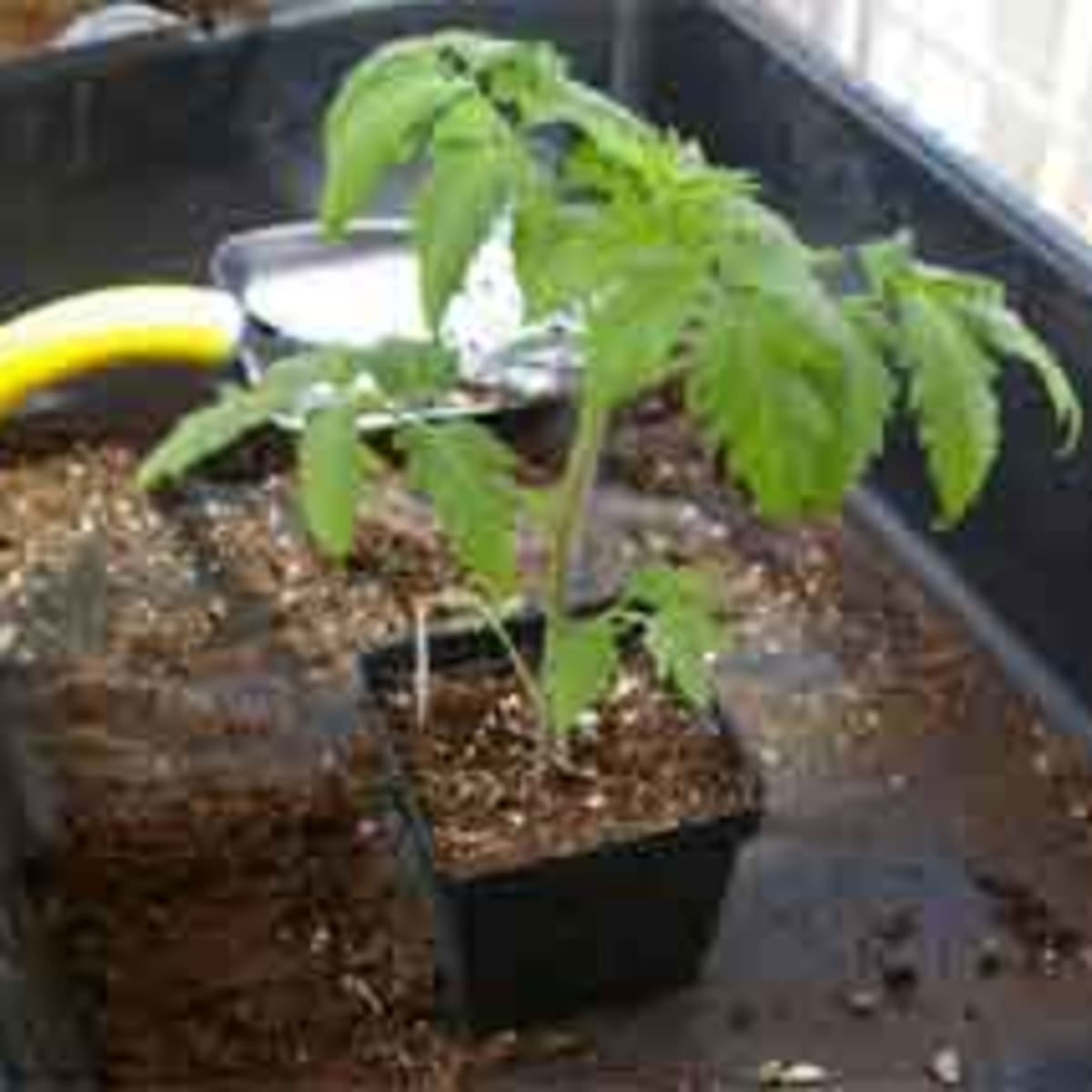To get thick stems on tomato plants, provide them with proper support and avoid over-watering or over-fertilizing. Growing tomato plants with thick stems is essential for their health and productivity.
Thick stems provide sturdy support for the plants, allowing them to bear the weight of their heavy fruit without bending or breaking. In addition, strong stems also improve the plants’ ability to take up water and nutrients, ensuring proper growth and development.
To achieve thicker stems, start by selecting the right tomato varieties known for their strong stem growth. Provide proper support for the plants using stakes or tomato cages to prevent them from sprawling on the ground. Avoid over-watering, as this can cause weak and stretched stems. Similarly, avoid over-fertilizing, as an excess of nitrogen can result in leggy growth without thick stems. With proper care and support, your tomato plants can develop thick, strong stems and thrive throughout the growing season.

Credit: www.reddit.com
Importance Of Thick Stems In Tomato Plants
Thick stems play a crucial role in the growth and development of tomato plants. One of the main benefits is that they provide strong support for the heavy fruit load that tomato plants can produce. When the stems are thicker, they are better equipped to hold the weight of multiple fruits, preventing them from snapping or bending.
In addition to providing support, thick stems also aid in efficient water and nutrient transport. The larger diameter allows for increased vascular tissue, which facilitates the movement of water and nutrients throughout the plant. This ensures that all parts of the plant receive the necessary resources for optimal growth and productivity.
Furthermore, tomato plants with thick stems are more resistant to diseases and pests. The stronger and sturdier stems are less susceptible to damage caused by pests or pathogens. Additionally, thicker stems provide a physical barrier, making it more difficult for pests to penetrate and attack the plant. This helps in maintaining the overall health and vigor of the tomato plants.
Factors Affecting Stem Thickness In Tomato Plants
Factors affecting stem thickness in tomato plants can be categorized into genetic factors, environmental conditions, nutrient availability, and proper pruning techniques.
Genetic Factors: The genetic makeup of tomato plants plays a critical role in stem thickness. Certain varieties naturally possess thicker stems compared to others. When selecting tomato plant varieties, consider ones that are known for their thick stems.
Environmental Conditions: Environmental factors such as temperature and humidity can impact stem thickness. Tomato plants thrive in warm and humid conditions. Providing the appropriate conditions, such as using heat mats or maintaining a greenhouse environment, can promote thicker stems.
Nutrient Availability: To develop thick and sturdy stems, tomato plants require the right balance of nutrients. Nitrogen, phosphorus, and potassium are essential for stem development. Ensuring a well-fertilized soil or using nutrient-rich compost can provide the necessary nutrients for robust stem growth.
Proper Pruning Techniques: Pruning can also influence stem thickness. Regularly removing suckers or side branches helps redirect the plant’s energy towards stem growth. Trimming excess foliage and limiting the number of stems can promote thicker and stronger main stems.
How to Get Thick Stems on Tomato Plants: Step by Step Guide
Choosing The Right Tomato Varieties
Choosing the right tomato varieties is crucial for developing thick stems on tomato plants. Indeterminate cultivars are a popular choice as they continuously grow and produce fruits until the first frost. These varieties have strong stems that can support the weight of the fruits. Additionally, heirloom varieties are known for their vigorous growth and thick stems.
They have been cultivated for generations and often have robust genetics that contribute to sturdy stems. On the other hand, disease-resistant hybrids are specially bred to withstand common tomato diseases. By selecting disease-resistant hybrids, you can ensure that your plants remain healthy and develop strong stems. When planting tomatoes, it is important to consider the variety to optimize stem thickness and overall plant health.
Creating Optimal Growing Conditions
Creating optimal growing conditions is essential for getting thick stems on tomato plants. When selecting a planting location, make sure to choose an area that receives adequate sunlight. Tomatoes need at least 6-8 hours of direct sunlight per day to thrive. Additionally, it is important to use well-draining soil to avoid waterlogged roots. Wet soil can lead to weak stems and root rot.
To maintain proper moisture levels, water the tomato plants regularly but avoid over-watering. A good rule of thumb is to water deeply once or twice a week, rather than lightly every day. This helps encourage deep root growth and stronger stems. By following these guidelines and providing the right conditions, you can successfully grow tomato plants with thick, strong stems.
Implementing Proper Pruning Techniques
Implementing proper pruning techniques is essential for achieving thick stems on tomato plants. One technique is removing suckers, which are secondary shoots that grow between the main stem and branches. Removing suckers directs the plant’s energy to the main stem, allowing it to grow thicker and stronger. Another important aspect is proper training and staking methods.
By providing support to the plant using stakes or cages, it allows the stem to grow vertically, reducing the risk of bending or breaking. Additionally, pruning for better air circulation is crucial. Trimming back excessive foliage helps create space between plants, allowing air to flow freely, preventing the development of diseases. Regular pruning, especially of damaged or diseased stems, promotes healthy growth and a strong overall structure for tomato plants.
Optimizing Nutrient Supply
Maximize the growth of your tomato plant stems by optimizing nutrient supply through proper fertilization techniques. Give your plants the essential nutrients they need to develop thick and sturdy stems for healthy growth and abundant harvests. Discover how to enhance the nutrient supply and promote strong stems for your tomato plants.
When it comes to growing tomato plants with thick stems, providing balanced fertilization is crucial. One of the key factors is incorporating organic matter into the soil. This helps improve its structure, allowing the roots to access vital nutrients more easily.
Avoid over-fertilization as it can lead to excessive vegetative growth, resulting in weak stems. It’s essential to carefully follow the recommended fertilizer application rates to prevent nutrient imbalances.
| Incorporating organic matter |
|---|
| • Add compost or well-rotted manure to the soil before planting tomatoes. |
| • Use organic mulch to retain moisture and slowly release nutrients. |
| • Consider using organic fertilizers or foliar sprays to supplement the soil’s nutrient content. |
| • Rotate crops to prevent nutrient depletion and promote overall soil health. |
| Avoiding over-fertilization |
| • Follow the recommended fertilizer application rates indicated on the product packaging. |
| • Monitor the growth and appearance of your tomato plants regularly. |
| • Adjust fertilization accordingly to prevent excessive vegetative growth. |
Applying Natural Supplements
One way to promote thick stems on tomato plants is by applying natural supplements. Seaweed extract is a popular option that provides essential minerals and nutrients to the plants. It helps stimulate the growth of thicker stems, resulting in stronger and healthier plants. Another natural supplement is compost tea, which is rich in organic matter and beneficial microorganisms. When applied to the soil around the plants, it helps improve soil fertility and enhances stem development.
Additionally, spraying aloe vera extract on the tomato plants can promote thicker stems. Aloe vera contains natural growth stimulators and helps strengthen the plant’s immune system. Regular application of these natural supplements can encourage the growth of thick stems and ultimately lead to robust and productive tomato plants.
Supplementing With Growth Hormones
Supplementing with growth hormones can help promote thick stems on tomato plants. One way to do this is by using rooting hormone for seedlings. This hormone contains the necessary ingredients to stimulate root development and enhance overall plant growth. When applying the hormone, make sure to follow the instructions provided and apply it directly to the base of the seedlings.
In addition to using rooting hormone, plant growth regulators can also be beneficial. These regulators help control the plant’s growth and development, resulting in stronger stems. They can be applied as a foliar spray or through irrigation. It is essential to remember to use plant growth regulators properly and in the correct concentrations to avoid any negative effects on the plants.
Implementing Stress Techniques
One way to encourage thick stems on tomato plants is by implementing various stress techniques. These techniques involve subjecting the plants to controlled watering and drought stress, light physical stress, and cold stress.
| Stress Technique | Description |
|---|---|
| Controlled watering and drought stress | By providing the plants with less frequent and deep watering, we can induce mild drought stress. This stimulates the plant to develop a stronger root system and thicker stems to withstand water scarcity. |
| Light physical stress | Gently brushing the stems of tomato plants with your hands or using a soft cloth can create a mild physical stress. This action prompts the plant to produce thicker stems and reinforce its structure. |
| Cold stress techniques | Exposing tomato plants to brief periods of cooler temperatures can promote thicker stems. Gradually lowering the temperature during the night or using a fan to create airflow can mimic the stress caused by colder conditions. |
Implementing these stress techniques can help tomato plants develop robust and sturdy stems, ultimately contributing to their overall health and productivity.
Ensuring Proper Disease And Pest Management
Ensuring the proper disease and pest management is crucial for achieving thick stems on tomato plants. Early detection and treatment of diseases play a significant role in preventing the spread of infections that can weaken the stems. Regularly inspect your plants for any signs of diseases, such as yellowing leaves, wilting, or mold. If you notice any symptoms, take immediate action by removing and destroying the affected parts and treating the plants with appropriate fungicides or pesticides.
Integrated pest management (IPM) techniques are also effective in controlling pests that can damage the stems. These techniques involve using a combination of cultural, biological, and chemical control methods to manage pests while minimizing harmful effects on the plants and the environment. By implementing these practices, you can proactively protect your tomato plants and encourage strong stem growth.
Frequently Asked Questions For How To Get Thick Stems On Tomato Plants
How Can I Encourage Thicker Stems On My Tomato Plants?
To encourage thicker stems on your tomato plants, try planting them deeper in the soil. This will promote root growth and result in stronger stems. Additionally, providing adequate support, such as using stakes or cages, will prevent the plants from bending or breaking, allowing the stems to become thicker over time.
What Nutrients Are Essential For Developing Thicker Stems In Tomato Plants?
Tomato plants require a balanced supply of nutrients to develop thicker stems. Specifically, they need sufficient amounts of calcium, potassium, and phosphorus. Calcium aids in cell wall development, potassium promotes overall plant strength, and phosphorus supports root and stem growth.
Incorporating organic matter or using fertilizer that contains these elements can help promote thicker stems in tomato plants.
Can Pruning Help In Thickening The Stems Of Tomato Plants?
Pruning tomato plants can indeed help in thickening their stems. By removing the lower branches and foliage, the plant’s energy is directed towards stem and fruit development. This promotes denser and sturdier stems. However, it is essential to prune selectively and avoid excessive trimming, as it might hinder overall plant growth and productivity.
Conclusion
To achieve thick stems on tomato plants, prioritize proper watering, provide adequate support, and maintain optimal temperature and light conditions. Prune the lower leaves regularly, focusing on the main stem’s bottom sections. This stimulates stem growth by redirecting energy towards the upper areas.
Remember to use organic fertilizers rich in potassium, which promotes sturdy stems. By following these techniques, you’ll ensure robust tomato plants with thick, healthy stems, contributing to their overall growth and productivity. Happy gardening!

